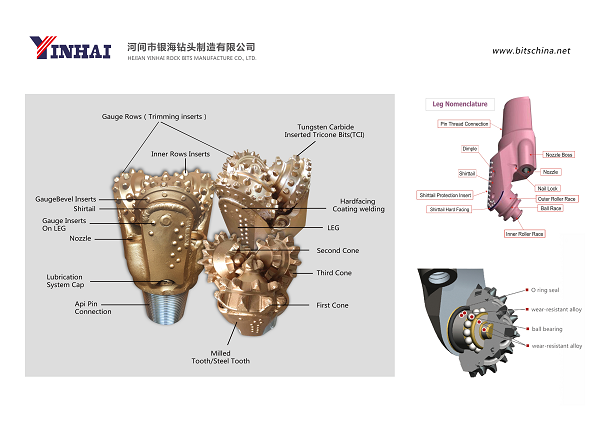Tricone Drill Bit Leg
The Drill Bits legs, when are welded together, provided the structural support for the bit. The central dimple is buildup of metal to provide additional supports. Destruction of the bit body occurs when the legs or the welding fails. Bit destruction weight is generally assumed to be approximately 10,000 Ib/in of bit diameter.
What Is The Roller Tricone Drill Bit Shirttail?
The lower exterior section of the bit leg is the” shirttail.” This area is an important part of the Cone bit body, because it is the only section that contacts the formation and therefore is subject to abrasive wearing. The shirttail is often protected from wear by inserts tungsten carbide, Unusual wearing in the shirttail area often indicates an undergauged hole that will give future problems when run a new, full-gauged bit.
Tricone Drill Bit Nozzle Shrouds
The tricone bits body is forged with nozzle shrouds for the jets in a jet type bit. The shroud is located in the middle exterior segment of the body between each leg and directs the fluid flow at the bottom of the hole. Specially designed bits have extended shrouds that move the jet nearer the hole bottom, and a newly developed bit has one of the three shrouds directed up the annular space.
What are other Drill Bit Design Factors Related To Bit Body ?
There are 2 important factors affecting the drill bit design which are journal angle bearing and offset angle
2nd Design Feature : Tricone Drill Bit Watercourses
An important part of a tricone Drill Bits Design is the watercourses, without which the rest of the rock bits could not function as intended. Watercourses are passageways for the circulating fluid, which primarily brings cuttings to the surface and cleans the formation below the bit. The design of the passageway sand nozzles that direct the fluid at the bit differentiates between the two types of watercourses:
1.conventional watercourses that direct the fluid onto the cutters
2.jet watercourses that direct the fluid to the bottom of the hole.
Drilling fluid passes from the Drill String and out through nozzles in the bit. As it passes across the face of the bit it carries the drilled cutting from the cones and into the annulus. The original design for rock bits only allowed the drilling mud to be ejected from the middle of the bit. This was not very efficient and led to a build up of cuttings on the face of the bit (bit balling) and cone erosion.
A more efficient method of cleaning the face of the bit was therefore introduced. The fluid is now generally ejected through three jet nozzles around the outside of the bit body. The turbulence created by the jet streams is enough to clean the cutters and allow efficient drilling to continue.
Post time: Oct-09-2022





